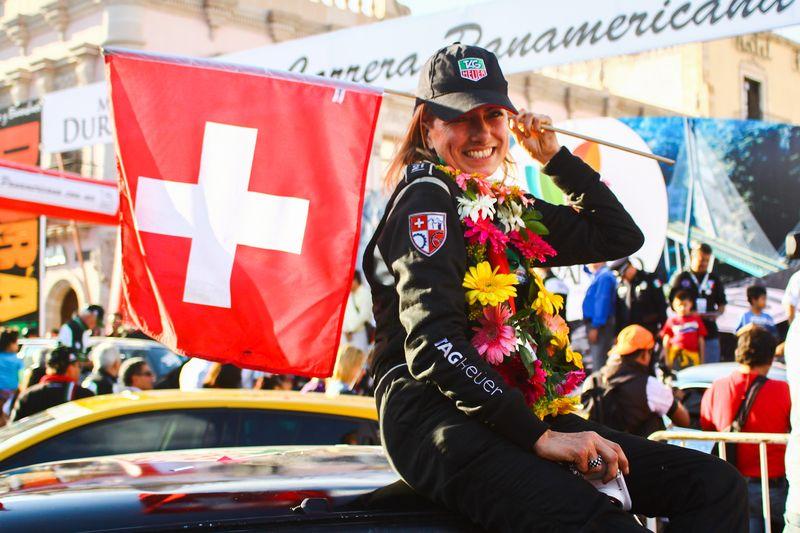The Art of Rally Racing -- Champion Isabelle de Sadeleer on Automobiles & Alpacas
02.02.2015 LifestyleAt her traditional wooden chalet in Gstaad, Ms de Sadeleer sat down with GSTAADLIFE to discuss her passion for everything on wheels, as well as her roots here in the region.
GL: How do you feel after such a win?
IdS: The Carrera Panamerica is a legendary racecourse that, just like for a good number of automobile-lovers, I’ve always dreamed of completing. To have won is the source of immense satisfaction on my part … for our team it certainly wasn’t a shoe-in.
GL: Tell us about the rally … is the journey really as dangerous as it’s reputed to be?
IdS: Our trip was full of challenges and inconveniences; after the first day we weren’t even sure that we’d make it through the course. And the two days following we thought we would have to abandon our car, a 1954 Studebaker is exceptionally dangerous to pilot. That said, we had the entire length of the rally to evolve with it.
Extreme speeds of up to 250 km/hr are common at a backbreaking pace on steep cliffs on much of the route. Nights are short, with a maximum five and a half hours sleep and permanent stress during a full week. A constantly elevated level of adrenaline is the only thing that allows drivers to stay the course.
Funnily enough, we had a sticker marked “Don’t crack under pressure”, our watchmaker partner TAG HEUER’s motto, stuck to our car. Everyone joked that we should keep repeating it in order to make it through the rally.
GL: And your experience with Mexico itself?
IdS: There were sometimes 30.000 spectators awaiting our arrival at certain points – it was as if the heart of the Mexican people was beating along with us, to the frantic rhythm of the course. I discovered the country and fell in love with Mexico, as we drove more than 7500 km including the course itself and the reconnaissance. The indescribable beauty of the countryside. The overwhelming kindness and respect of the Mexican people, even in the middle of nowhere. These emotions were so profound I could write a book about them.
GL: How did you meet your rally partner, former Formula One racer Erik Comas?
IdS: I met Erik Comas nearly 10 years ago at the “Snow & Ice” rally. We quickly became fast friends and started to do rallys together. We won the “Tour Auto” twice, once in 2008 with an Alpine Renault A 110 Groupe 4, and the second in 2013 driving a Lancia Stratos Groupe 4.
GL: How long have you been interested in racing?
IdS: I’ve been attracted to cars as long as I can remember. Even as a child I preferred little pedal cars and Dinky toys to dolls! This passion only grew stronger with years.
I have many hobbies but my real passions are vintage and supercars, as well as animals. With my friends Hansueli Brand and Stéphane Gutzwiller, I founded the Gstaad Automobile Club nearly 10 years ago. On February 28, 2015 we are organising a big party to celebrate this anniversary.
GL: It is true that four-wheeled passion runs in the family, with two of your three sons racing as well?
IdS: My youngest son, 17-year old Hugo, is also a professional driver – all while pursuing studies at Institut le Rosey. He drives a Formula Renault 2 litres in the Tech One team directed by Sarah and Simon Abadi. Hugo has also been passionate about motor sports including motorcycles, karting and airplanes since a tender age. This year he passed his private pilot license.
My eldest son Jérôme and his friend Caroline also participated in the Carrera Panamerica, at the wheel of a 1965 Ford Falcon. It was incredible to drive the rally simulataneously.
GL: Do you cheer Hugo on as a fellow racer or worry like a mother when he races?
IdS: My mother’s instinct is stronger than my love of racing. So of course, like all other moms in the world, I’m nervous and anxious when I see him race.
GL: Why do you spend time here in Gstaad and Saanenland?
IdS: Gstaad represents my roots – I’m very attached to the region. My children were born in Switzerland and spent their entire education at the John F. Kennedy School and afterwards at Institut Le Rosey. For me it’s a haven of peace; I love to come back here after my travels and I always have the same warm, happy feeling to be back in my chalet. My children feel exactly the same way. After living in New York for several years and now London, as soon as we enter the front door they always say: “It feels so good to be home again.”
GL: Do you feel Swiss despite your international background?
IdS: I was born in France but my great-grandparents on both sides were Swiss. I’ve always had a strong affinity for this country and for the Saanenland in particular – I’ve had a chalet here for more than 30 years now. So although I’m Swiss by nationality, and at heart, I do spend much of the year in Gibraltar, Monaco, the Caribbean, and London, where two of my sons, Jérôme and Arnaury, live.
GL: You appear to be a Jill of many trades. What is your professional background?
IdS: I studied at an International school in France and later pursed my education in stylisme in Paris. I’ve always loved drawing and painting, and even started to make the traditional cut-outs, decoupages, when I arrived in Gstaad. I also do a lot of decorating, which is something I continue to do from my home in the Caribbean.
GL: We hear you’re awfully fond of animals.
IdS: Until last year I also ran an alpaca farm, where we had over 100 of these adorable little animals from South America. I raised them for 25 years – they have truly extraordinary personalities. The social attachments they create could be compared to that of elephants, and their memories too! I dedicated a lot of energy my alpacas, and both my veterinarian and I learned to take care of them over time. Years later, we were receiving calls from other veterinarians and zookeepers from all over Europe, asking us for advice. I still have an immense tenderness for these creatures. I miss my animals every day, but life changes with time – children grow up and our way of living as well.




